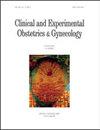Health-Related Quality of Life with Cervical Cancer and Precancer: A Cross-Sectional Study in Yunnan Province, China
IF 0.6
4区 医学
Q4 OBSTETRICS & GYNECOLOGY
引用次数: 0
Abstract
Background: Cervical cancer is the fourth most common cancer in women, with an estimated 600,000 new cases and 340,000 deaths worldwide in 2020. However, there remains limited understanding of the association between individual socioeconomic status, clinical characteristics, and health-related quality of life (HRQoL) of women with cervical precancerous lesions. This study investigates socioeconomic and clinical variations in HRQoL of women with cervical precancerous lesions and cervical cancer in Yunnan Province, China. Methods: The present study employed a cross-sectional survey design. An EuroQol Five Dimensions Five Level (EQ-5D-5L) questionnaire was used to assess HRQoL of 400 patients with cervical precancerous lesions and cervical cancer in Yunnan Province, China, from 2019 to 2020. Analysis of variance (ANOVA) and independent samples t-tests were performed to identify the independent variables associated with EQ-5D-5L utility scores and visual analogue scale (VAS) scores. Predictors of utility scores were confirmed using a Tobit regression model. Results: The mean EQ-5D-5L utility scores of cervical precancerous lesions and cervical cancer patients was 0.939 (standard deviation (SD), 0.104), and the mean VAS score was 80.84 (SD, 16.551). Patients aged 40–59 years (β = –0.037, p = 0.005), patients who were not aware of the human papillomavirus (HPV) vaccine (β = –0.032, p = 0.004), and patients who underwent radical hysterectomy (β = –0.036, p = 0.006) had significantly lower utility scores, whereas having high monthly household income (β = 0.023, p = 0.033) was significantly associated with higher EQ-5D-5L utility scores. Age (p = 0.023) was statistically significant in differences in patients’ VAS scores. Anxiety/depression was the most frequently reported issue (35.75%) among participants. Conclusions: Future cervical cancer prevention and treatment guidelines should focus on low-income women, women aged 40–59 years, and those lacking knowledge about cervical cancer prevention.与宫颈癌和癌前病变相关的生活质量:中国云南省的一项横断面研究
背景:宫颈癌是女性中第四大常见癌症,预计2020年全球将有60万新病例和34万例死亡。然而,对于宫颈癌前病变妇女的个体社会经济地位、临床特征和健康相关生活质量(HRQoL)之间的关系,人们的理解仍然有限。本研究调查了中国云南省宫颈癌前病变和宫颈癌妇女HRQoL的社会经济和临床变化。方法:本研究采用横断面调查设计。采用EuroQol五维度五水平(EQ-5D-5L)问卷对2019 - 2020年云南省400例宫颈癌前病变和宫颈癌患者的HRQoL进行评估。采用方差分析(ANOVA)和独立样本t检验来确定与EQ-5D-5L效用评分和视觉模拟量表(VAS)评分相关的自变量。使用Tobit回归模型确认效用得分的预测因子。结果:宫颈癌前病变与宫颈癌患者EQ-5D-5L效用评分均值为0.939(标准差为0.104),VAS评分均值为80.84(标准差为16.551)。40-59岁患者(β = -0.037, p = 0.005)、未接种人乳头瘤病毒(HPV)疫苗的患者(β = -0.032, p = 0.004)和接受根治性子宫切除术的患者(β = -0.036, p = 0.006)效用得分显著降低,而家庭月收入高(β = 0.023, p = 0.033)与EQ-5D-5L效用得分显著升高相关。患者VAS评分的年龄差异有统计学意义(p = 0.023)。焦虑/抑郁是参与者中最常报告的问题(35.75%)。结论:今后宫颈癌防治指南应重点关注低收入妇女、40 ~ 59岁妇女和缺乏宫颈癌预防知识的妇女。
本文章由计算机程序翻译,如有差异,请以英文原文为准。
求助全文
约1分钟内获得全文
求助全文
来源期刊
CiteScore
0.50
自引率
0.00%
发文量
241
审稿时长
1 months
期刊介绍:
CEOG is an international, peer-reviewed, open access journal. CEOG covers all aspects of Obstetrics and Gynecology, including obstetrics, prenatal diagnosis, maternal-fetal medicine, perinatology, general gynecology, gynecologic oncology, uro-gynecology, reproductive medicine, infertility, reproductive endocrinology, sexual medicine. All submissions of cutting-edge advances of medical research in the area of women''s health worldwide are encouraged.

 求助内容:
求助内容: 应助结果提醒方式:
应助结果提醒方式:


